《动物免疫学》课程PPT教学课件(讲稿)免疫系统的遗传学(Genetics of the Immune system)
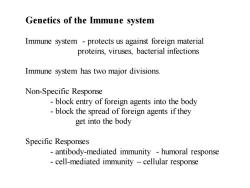
Genetics of the Immune system Immune system -protects us against foreign material proteins,viruses,bacterial infections Immune system has two major divisions. Non-Specific Response block entry of foreign agents into the body block the spread of foreign agents if they get into the body Specific Responses antibody-mediated immunity -humoral response cell-mediated immunity -cellular response
Genetics of the Immune system Immune system - protects us against foreign material proteins, viruses, bacterial infections Immune system has two major divisions. Non-Specific Response - block entry of foreign agents into the body - block the spread of foreign agents if they get into the body Specific Responses - antibody-mediated immunity - humoral response - cell-mediated immunity – cellular response
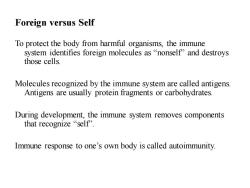
Foreign versus Self To protect the body from harmful organisms,the immune system identifies foreign molecules as "nonself'and destroys those cells. Molecules recognized by the immune system are called antigens. Antigens are usually protein fragments or carbohydrates. During development,the immune system removes components that recognize "self'. Immune response to one's own body is called autoimmunity
Foreign versus Self To protect the body from harmful organisms, the immune system identifies foreign molecules as “nonself” and destroys those cells. Molecules recognized by the immune system are called antigens. Antigens are usually protein fragments or carbohydrates. During development, the immune system removes components that recognize “self”. Immune response to one’s own body is called autoimmunity
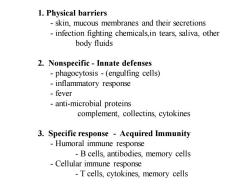
1.Physical barriers -skin,mucous membranes and their secretions infection fighting chemicals,in tears,saliva,other body fluids 2.Nonspecific-Innate defenses phagocytosis-(engulfing cells) inflammatory response fever anti-microbial proteins complement,collectins,cytokines 3.Specific response Acquired Immunity -Humoral immune response -B cells,antibodies,memory cells Cellular immune response T cells,cytokines,memory cells
1. Physical barriers - skin, mucous membranes and their secretions - infection fighting chemicals,in tears, saliva, other body fluids 2. Nonspecific - Innate defenses - phagocytosis - (engulfing cells) - inflammatory response - fever - anti-microbial proteins complement, collectins, cytokines 3. Specific response - Acquired Immunity - Humoral immune response - B cells, antibodies, memory cells - Cellular immune response - T cells, cytokines, memory cells
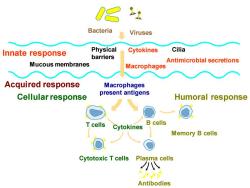
Bacteria Viruses Innate response Physical Cytokines Cilia barriers Antimicrobial secretions Mucous membranes Macrophages Acquired response Macrophages Cellular response present antigens Humoral response T cells B cells Cytokines Memory B cells Cytotoxic T cells Plasma cells Antibodies
Bacteria Viruses Acquired response Mucous membranes Physical barriers Cilia Innate response Cytokines Antimicrobial secretions Macrophages Macrophages present antigens Cellular response T cells Cytokines Cytotoxic T cells Humoral response B cells Memory B cells Plasma cells Antibodies
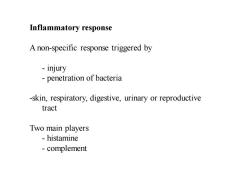
Inflammatory response A non-specific response triggered by injury penetration of bacteria -skin,respiratory,digestive,urinary or reproductive tract Two main players -histamine complement
Inflammatory response A non-specific response triggered by - injury - penetration of bacteria -skin, respiratory, digestive, urinary or reproductive tract Two main players - histamine - complement
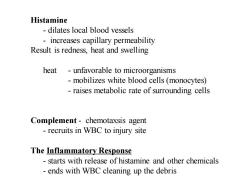
Histamine dilates local blood vessels increases capillary permeability Result is redness,heat and swelling heat unfavorable to microorganisms mobilizes white blood cells(monocytes) raises metabolic rate of surrounding cells Complement-chemotaxsis agent recruits in WBC to injury site The Inflammatory Response starts with release of histamine and other chemicals ends with WBC cleaning up the debris
Histamine - dilates local blood vessels - increases capillary permeability Result is redness, heat and swelling heat - unfavorable to microorganisms - mobilizes white blood cells (monocytes) - raises metabolic rate of surrounding cells Complement - chemotaxsis agent - recruits in WBC to injury site The Inflammatory Response - starts with release of histamine and other chemicals - ends with WBC cleaning up the debris
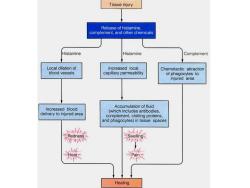
Tissue injury Release of histamine. complement,and other chemicals Histamine Histamine Complement Local dilation of Increased local Chemotactic attraction blood vessels capillary permeability of phagocytes to injured area Increased blood Accumulation of fluid (which includes antibodies. delivery to injured area complement,clotting proteins. and phagocytes)in tissue spaces AL/E乡 Swelling Healing
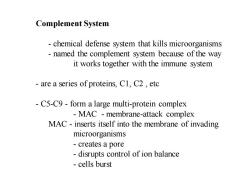
Complement System chemical defense system that kills microorganisms named the complement system because of the way it works together with the immune system are a series of proteins,C1,C2,etc C5-C9-form a large multi-protein complex MAC -membrane-attack complex MAC-inserts itself into the membrane of invading microorganisms creates a pore disrupts control of ion balance cells burst
Complement System - chemical defense system that kills microorganisms - named the complement system because of the way it works together with the immune system - are a series of proteins, C1, C2 , etc - C5-C9 - form a large multi-protein complex - MAC - membrane-attack complex MAC - inserts itself into the membrane of invading microorganisms - creates a pore - disrupts control of ion balance - cells burst
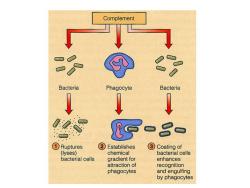
Complement Bacteria Phagocyte Bacteria ①)Ruptures ②Establishes ③Coating of (lyses) chemical bacterial cells bacterial cells gradient for enhances attraction of recognition phagocytes and engulfing by phagocytes
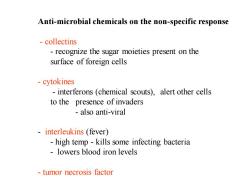
Anti-microbial chemicals on the non-specific response collectins recognize the sugar moieties present on the surface of foreign cells -cytokines interferons (chemical scouts),alert other cells to the presence of invaders also anti-viral interleukins (fever) high temp-kills some infecting bacteria lowers blood iron levels tumor necrosis factor
Anti-microbial chemicals on the non-specific response - collectins - recognize the sugar moieties present on the surface of foreign cells - cytokines - interferons (chemical scouts), alert other cells to the presence of invaders - also anti-viral - interleukins (fever) - high temp - kills some infecting bacteria - lowers blood iron levels - tumor necrosis factor
按次数下载不扣除下载券;
注册用户24小时内重复下载只扣除一次;
顺序:VIP每日次数-->可用次数-->下载券;
- 《动物免疫学》课程PPT教学课件(讲稿)免疫系统(The Immune System).ppt
- 《动物免疫学》课程PPT教学课件(讲稿)免疫球蛋白(Immunoglobulin, Ig).ppt
- 《动物免疫学》课程PPT教学课件(讲稿)免疫标记技术及应用.ppt
- 《动物免疫学》课程PPT教学课件(讲稿)免疫应答概述(Immune response).ppt
- 《动物免疫学》课程PPT教学课件(讲稿)免疫学概论.ppt
- 《动物免疫学》课程PPT教学课件(讲稿)免疫学发展简史及展望.ppt
- 《动物免疫学》课程PPT教学课件(讲稿)体液免疫反应 Humoral Immune Response.ppt
- 《动物免疫学》课程PPT教学课件(讲稿)传染与免疫(病原体对机体的感染、机体对感染的预防和治疗).ppt
- 《动物免疫学》课程PPT教学课件(讲稿)主要组织相容性抗原系统(histicompatibility antigen).ppt
- 《动物免疫学》课程PPT教学课件(讲稿)主要组织相容性复合体及其编码分子.ppt
- 《动物免疫学》课程PPT教学课件(讲稿)主要的补体系统缺乏(Primary deficiencies of the complement system).ppt
- 《动物免疫学》课程PPT教学课件(讲稿)T淋巴细胞与特异性细胞免疫.ppt
- 《动物免疫学》课程PPT教学课件(讲稿)Cellular Cooperation and Antigen Recognition.ppt
- 《动物免疫学》课程PPT教学课件(讲稿)IL-8生物活性的检测.ppt
- 《动物免疫学》课程PPT教学课件(讲稿)细胞因子 Cytokines.ppt
- 《动物免疫学》课程PPT教学课件(讲稿)B细胞的生物学(Biology of the B Lymphocyte).ppt
- 《动物免疫学》课程PPT教学课件(讲稿)B细胞对抗原的识别和应答.ppt
- 《动物免疫学》课程PPT教学课件(讲稿)Antigen Recognition.ppt
- 《动物免疫学》课程PPT教学课件(讲稿)Antibody-Antigen Reactions.ppt
- 《动物免疫学》课程教学资源(文献资料)补体 Complement(英文)1.pdf
- 《动物免疫学》课程PPT教学课件(讲稿)免疫耐受 Immunological Tolerance.ppt
- 《动物免疫学》课程PPT教学课件(讲稿)免疫自动化仪器分析.ppt
- 《动物免疫学》课程PPT教学课件(讲稿)抗原(Antigen, Ag).ppt
- 《动物免疫学》课程PPT教学课件(讲稿)抗体-抗原反应(Antibody-Antigen Reactions).ppt
- 《动物免疫学》课程PPT教学课件(讲稿)抗体产生的多样性(英文).ppt
- 《动物免疫学》课程PPT教学课件(讲稿)抗原、受体和球蛋白 Antigens, Receptors and Immunoglobulins.ppt
- 西南民族大学:《动物免疫学》课程PPT教学课件(讲稿)抗原抗体反应 antigen-antibody reaction(主讲:岳华).ppt
- 《动物免疫学》课程PPT教学课件(讲稿)B淋巴细胞与特异性体液免疫.ppt
- 《动物免疫学》课程PPT教学课件(讲稿)淋巴细胞抗原识别受体的编码及多样性的产生.ppt
- 《动物免疫学》课程PPT教学课件(讲稿)白细胞分化抗原和黏附分子.ppt
- 《动物免疫学》课程PPT教学课件(讲稿)补体系统(激活、调节、生物学作用).ppt
- 《动物免疫学》课程PPT教学课件(讲稿)补体系统和细胞因子.ppt
- 《动物免疫学》课程PPT教学课件(讲稿)补体系统(The Complement System).ppt
- 《动物免疫学》课程PPT教学课件(讲稿)超敏反应(1)Hypersensitivity Reactions.ppt
- 《动物免疫学》课程PPT教学课件(讲稿)超敏反应 Hypersensitivity.ppt
- 《动物免疫学》课程PPT教学课件(讲稿)超敏反应(2-5型)Hypersensitivity Types II-V.ppt
- 《动物免疫学》课程PPT教学课件(讲稿)非特异性免疫的组成细胞及功能.ppt
- 广东海洋大学:《动物繁殖学》课程教学大纲 Animal Reproduction(打印版).pdf
- 广东海洋大学:《动物繁殖学》课程教学课件(PPT讲稿)第一章 绪论 Animal Reproduction(负责人:安立龙).ppt
- 广东海洋大学:《动物繁殖学》课程授课教案(打印版,主讲:安立龙、巨向红).pdf
